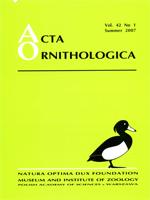Great- and Middle Spotted Woodpecker nest-hole dimensions and tree diameters at hole-entrance height were analyzed in order to test the hypothesis that Middle Spotted Woodpeckers, by making use of a thinner substrate and excavating smaller nest-holes, may reduce interspecific competition for nest-sites with Great Spotted Woodpeckers. It was found that only the vertical diameter of Great Spotted Woodpecker nest-hole openings and the entrance-hole area (49.2 mm, 17.8 cm2 respectively) were significantly larger than the corresponding parameters in Middle Spotted Woodpeckers (44.9 mm, 16.2 cm2). The average tree diameter at nest-height was 42.7 cm in Great Spotted Woodpeckers and 38.2 cm in Middle Spotted Woodpeckers, and did not differ between the two species. There were no correlations between the tree diameter at nest height and nest height in either species. The small variation in hole-entrance diameters (CV ≤ 10%) and the distance that a predator had to reach to plunder the nest (≥ 19 cm) are most likely to protect woodpeckers' broods against arboreal predators — mainly Pine Martens. It is concluded that the tree diameter at nest-height probably makes little or no difference with respect to avoidance by Middle Spotted Woodpeckers of competition with Great Spotted Woodpeckers. The role of nest-hole size in terms of its influence on reproduction is also discussed.
How to translate text using browser tools
1 July 2007
Nest Holes of Great Spotted Woodpeckers Dendrocopos major and Middle Spotted Woodpeckers D. medius: Do they Really Differ in Size?
Ziemowit Kosiński,
Paweł Ksit

Acta Ornithologica
Vol. 42 • No. 1
July 2007
Vol. 42 • No. 1
July 2007
cavity kleptoparasitism
Dendrocopos major
Dendrocopos medius
Great Spotted Woodpecker
Middle Spotted Woodpecker
nest-hole dimension
substrate thickness




